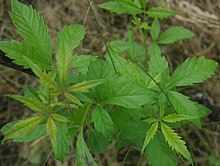bio.wikisort.org - Plant
Vitex negundo, commonly known as the Chinese chaste tree,[2] five-leaved chaste tree, or horseshoe vitex, or nisinda is a large aromatic shrub with quadrangular, densely whitish, tomentose branchlets. It is widely used in folk medicine, particularly in South and Southeast Asia.



Vitex negundo is an erect shrub or small tree growing from 2 to 8 m (6.6 to 26.2 ft) in height. The bark is reddish brown. Its leaves are digitate, with five lanceolate leaflets, sometimes three. Each leaflet is around 4 to 10 cm (1.6 to 3.9 in) in length, with the central leaflet being the largest and possessing a stalk. The leaf edges are toothed or serrated and the bottom surface is covered in hair.[3] The numerous flowers are borne in panicles 10 to 20 cm (3.9 to 7.9 in) in length. Each is around 6 to 7 cm (2.4 to 2.8 in) long and are white to blue in color. The petals are of different lengths, with the middle lower lobe being the longest. Both the corolla and calyx are covered in dense hairs.[3]
The fruit is a succulent drupe, 4 mm (0.16 in) in diameter, rounded to egg-shaped. It is black or purple when ripe.[3]
Distribution and habitat
Vitex negundo is native to tropical Eastern and Southern Africa and Asia. It is widely cultivated and naturalized elsewhere.[1]
Countries it is indigenous to include Afghanistan, Bangladesh, Bhutan, Cambodia, China, India, Indonesia, Japan, Korea, Kenya, Madagascar, Malaysia, Mozambique, Myanmar, Nepal, Pakistan, the Philippines, Sri Lanka, Taiwan, Tanzania, Thailand, and Vietnam.[1]
Vitex negundo are commonly found near bodies of water, recently disturbed land, grasslands, and mixed open forests.[4]
Nomenclature
Common names of Vitex negunda in different languages include:[5]
- Assamese: Posotiya (পচতীয়া)
- Bengali: Nirgundi; Nishinda; Samalu
- Bontok: Liñgei
- Chinese: Huáng jīng (黄荆)
- English: Five-leaved chaste tree; Horseshoe vitex; Chinese chaste tree
- Filipino: Lagundî[4]
- Gujarati: Nagoda; Shamalic
- Hindi: Mewri; Nirgundi; Nisinda; Sambhalu; Sawbhalu (निर्गुंडी)
- Ifugao: Dabtan
- Ilokano: Dangla[4]
- Kannada: Biḷi nekki (ಬಿಳಿ ನೆಕ್ಕಿ)
- Korean: jommokhyeong (좀목형)
- Malayalam: Karinochi (കരിനൊച്ചി)
- Marathi: Nirgudi (निरगुडी)
- Nepali: 'सिमली' 'Simali' 'Nirgundi'
- Punjabi: Banna; Marwan; Maura; Mawa; Swanjan Torbanna
- Sanskrit: Nirgundi; Sephalika; Sindhuvara; Svetasurasa; Vrikshaha (सिन्धुवार)
- Sinhala: Nika (නික)
- Konkani: Lingad
- Tamil: Chinduvaram; Nirnochchi; Nochchi; Notchi; Vellai-nochchi (நொச்சி / கரு நொச்சி)
- Telugu: Sindhuvara; Vavili; Nalla-vavili; Tella-vavili (వావిలి / సింధువార) lekkali
- Urdu: Sumbaloo
- Odia: Begunia
Chemistry
The principal constituents of the leaf juice are casticin, isoorientin, chrysophenol D, luteolin, p–hydroxybenzoic acid and D-fructose.[citation needed] The main constituents of the oil are sabinene, linalool, terpinen-4-ol, β-caryophyllene, α-guaiene and globulol constituting 61.8% of the oil.[citation needed]
Uses
Purified extracts are believed to have medicinal properties.[6]
Vitex negundo is used for treating stored garlic against pests and as a cough remedy in the Philippines, sold under the trade names Ascof and Plemex.[7] In Malaysia, it is used in traditional herbal medicine for women's health, including treatments for regulating the menstrual cycle, fibrocystic breast disease and post-partum remedies.[8]
References
- "Vitex negundo L." Germplasm Resources Information Network (GRIN). Agricultural Research Service (ARS), United States Department of Agriculture (USDA). Retrieved September 7, 2011.
- USDA, NRCS (n.d.). "Vitex negundo". The PLANTS Database (plants.usda.gov). Greensboro, North Carolina: National Plant Data Team. Retrieved 6 August 2015.
- Vitex negundo Linn. Fact Sheet (PDF). Bureau of Plant Industry, Department of Agriculture, Republic of the Philippines.
- "Vitex negundo L. - Lagundi". Prosea Herbal Techno-Catalog. Archived from the original on December 21, 2012. Retrieved September 7, 2011.
- Vitex negunda in Dr. K. M. Madkarni's Indian Materia Medica; Edited by A. K. Nadkarni, Popular Prakashan, Bombay, 1976, pp: 1278-80.
- Zheng, Cheng-Jian; Li, Hua-Qiang; Ren, Shan-Cheng; Xu, Chuan-Liang; Rahman, Khalid; Qin, Lu-Ping; Sun, Ying-Hao (2015-01-30). "Phytochemical and Pharmacological Profile of Vitex negundo". Phytotherapy Research. 29 (5): 633–647. doi:10.1002/ptr.5303. ISSN 0951-418X.
- "Lagundi leaves as effective control against storage pests of garlic". Philippine Council for Agriculture, Forestry and Natural Resources Research and Development (PCARRD), Department of Science and Technology, Republic of the Philippines. Archived from the original on July 15, 2007. Retrieved September 7, 2011.
- Wan Hassan, W.E. (2010). Ulam: Salad Herbs of Malaysia. Masbe Sdn. Bhd. pp. 106–107. ISBN 9789834466404.
External links
- Caldecott, Todd (2006). Ayurveda: The Divine Science of Life. Elsevier/Mosby. ISBN 0-7234-3410-7. Contains a detailed monograph on Vitex negundo (Nirgundi) as well as a discussion of health benefits and usage in clinical practice. Available online at https://web.archive.org/web/20110403032108/http://www.toddcaldecott.com/index.php/herbs/learning-herbs/315-nirgundi
Другой контент может иметь иную лицензию. Перед использованием материалов сайта WikiSort.org внимательно изучите правила лицензирования конкретных элементов наполнения сайта.
WikiSort.org - проект по пересортировке и дополнению контента Википедии
